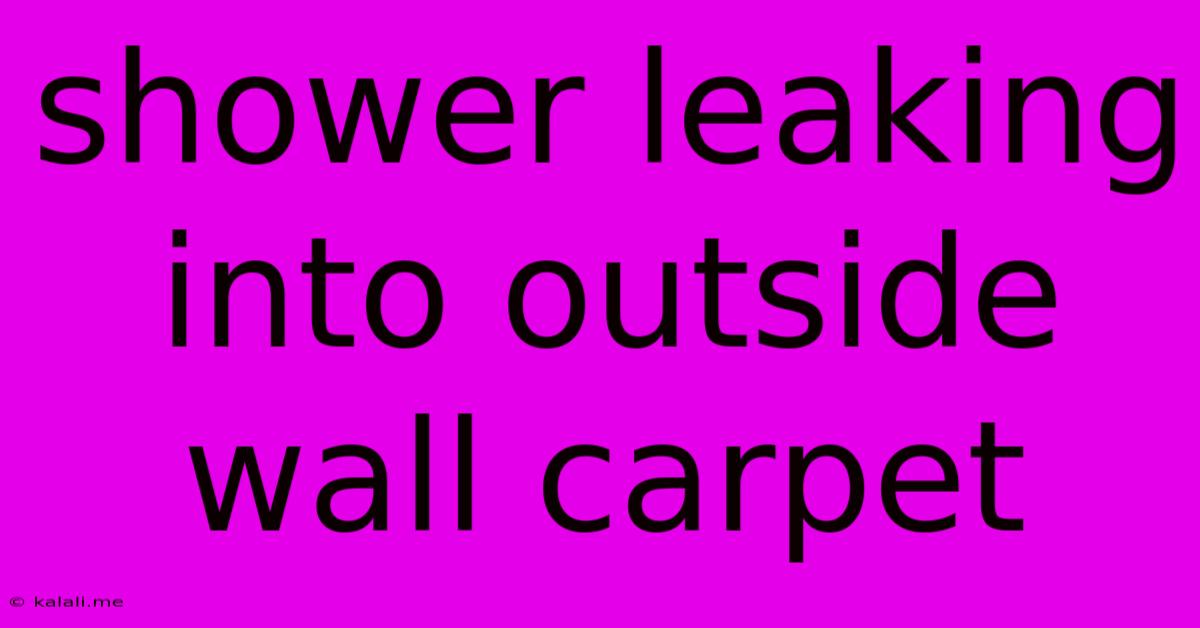Shower Leaking Into Outside Wall Carpet
Kalali
Jun 07, 2025 · 3 min read

Table of Contents
Shower Leaking into Outside Wall Carpet: Diagnosis and Solutions
Meta Description: Dealing with a shower leak affecting your outside wall carpet? This guide helps diagnose the problem, understand the potential damage, and outlines effective solutions to prevent further water damage and costly repairs. Learn how to identify the source and fix the leak yourself, or when to call a professional.
A shower leak seeping into your outside wall carpet is a serious issue demanding immediate attention. Ignoring it can lead to significant water damage, mold growth, structural problems, and costly repairs. This article will guide you through the process of identifying the source of the leak, assessing the damage, and implementing effective solutions.
Identifying the Source of the Leak
The first step is pinpointing the origin of the water. This often requires careful observation and, sometimes, a bit of detective work.
- Inspect the shower enclosure: Begin by thoroughly examining your shower for visible cracks in the grout, loose tiles, or damaged caulking around the shower pan, walls, and doors. Pay close attention to the area where the shower walls meet the floor. A small crack can cause significant water leakage over time.
- Check the showerhead and valves: Make sure the showerhead is securely attached and there are no leaks around the valve handles or pipes. Run the shower for a short period and carefully observe for dripping or spraying.
- Examine the drain: A clogged or improperly installed drain can cause water to back up and seep through the shower floor. Look for signs of water pooling around the drain.
- Investigate the plumbing: Look for any signs of leaks in the pipes supplying water to the shower. This may require accessing the plumbing behind the shower walls, which might involve removing some tiles or drywall.
- Check the waterproofing membrane: Behind the tiles is a waterproof membrane. Damage to this membrane is a major cause of leaks. Unfortunately, inspecting this typically requires some demolition.
Assessing the Damage
Once you've located the leak, it’s crucial to assess the extent of the damage. This involves:
- Checking the carpet: If the carpet is wet, it needs immediate removal to prevent mold growth. The underlayment may also be affected and require replacement.
- Inspecting the wall: Check for water stains or discoloration on the outside wall. Tap the wall to check for softness or hollowness – signs of water damage.
- Checking for mold: Mold can thrive in damp environments, causing health problems. Look for black, green, or gray discoloration, especially in hidden areas.
Solutions to the Shower Leak
The solution will depend on the source of the leak.
- Minor grout or caulking issues: These can often be fixed with a simple repair using grout or caulk. Ensure the surface is clean and dry before applying the new material.
- Damaged tiles: Replacing damaged or cracked tiles is necessary to prevent further leakage. This involves removing the affected tiles and replacing them with new ones, ensuring proper sealing.
- Plumbing leaks: Repairing or replacing leaky pipes requires plumbing expertise. This is a job best left to a qualified professional to prevent further damage and ensure correct plumbing.
- Waterproofing membrane failure: This usually requires significant repair work, including possibly removing and replacing sections of the wall. A professional should handle this repair.
- Major structural damage: In extreme cases of prolonged leakage, structural damage may have occurred. This could necessitate the help of a structural engineer and significant repairs.
When to Call a Professional
If you're not comfortable tackling the repair yourself, or if the damage appears extensive, it’s crucial to contact a qualified plumber or contractor. Professional help is recommended for:
- Significant plumbing issues: Working with plumbing requires specialized skills and tools.
- Extensive water damage: Professional remediation is crucial to prevent mold growth and structural damage.
- Issues with the waterproofing membrane: This is a complex repair best left to experienced professionals.
Addressing a shower leak promptly is critical to minimizing damage and preventing costly repairs. By following these steps and knowing when to call in a professional, you can effectively address this problem and protect your home.
Latest Posts
Latest Posts
-
Shes Like A Dog Bone Meaning
Jun 07, 2025
-
Best Spells To Use On Steel Defender
Jun 07, 2025
-
Should Non Catholics Make The Sign Of The Cross
Jun 07, 2025
-
I Have A Sump Pump Hole Is It Causing Radon
Jun 07, 2025
-
How Long Will Fresh Fish Last In Fridge
Jun 07, 2025
Related Post
Thank you for visiting our website which covers about Shower Leaking Into Outside Wall Carpet . We hope the information provided has been useful to you. Feel free to contact us if you have any questions or need further assistance. See you next time and don't miss to bookmark.